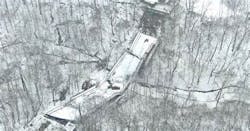NTSB Blames Fern Hollow Bridge Collapse on City, State, and Feds
On Jan. 28, 2022, the Fern Hollow Bridge in Pittsburgh, PA. collapsed in the early hours of the morning. After investigating the cause of the collapse, the National Transportation Safety Board (NTSB), on Wednesday, blamed the city of Pittsburgh for years of neglect by allowing severe corrosion and decay to weaken the span. They also blamed state and federal regulators for their lack of diligent oversight.
“This bridge did not collapse by an act of God. It collapsed because of a lack of maintenance and repair. It is just sad for the city,” board member Michael Graham said.
According to investigators, at the time of the collapse, the bridge should not have been open to traffic.
The NTSB voted unanimously to accept investigators' findings that the failure of the bridge was on a transverse tie plate, part of one of the legs of the structure. However, they said the probably cause and origin of the collapse were more broad and deep than the breakdown of a single piece of metal.
The collapse was pinned to an inspectors' "repeated" maintenance and repair recommendations. Investigators criticized the "poor quality" of inspections, noting flaws in identifying which bridge components could have brought the span down if they failed.
They also found faults with calculations for how much weight the bridge could hold.
“The ultimate responsibility for safety of this bridge is on the City of Pittsburgh, solely on the City of Pittsburgh. They own the bridge,” NTSB Chairwoman Jennifer Homendy said after the hearing.
Homendy said that the photographs attached to the inspection reports showed “progressive deterioration … to the point of absolute destruction.”
“The information was there. They had it,” she said. “They didn’t use it. They didn’t follow up and invest the money and resources into making the repairs that were called for.”
NTSB investigators also found insufficient oversight by the Pennsylvania Department of Transportation (PennDOT) and the Federal Highway Administration (FHWA) to ensure the bridge inspection program was carried out effectively, that repairs were made, and load ratings were accurate.
Dennis Collins, NTSB's lead investigator, said that attempts by NTSB officials to understand the rationale for the lack of maintenance by the previous administration were unsuccessful.
“The quality of the record keeping … was low, and the high staff turnover in the department as a whole really prevented us from getting any sort of answer,” Collins said.
Investigators said they found that the bridge drains were clogged and not regularly cleaned out. The clogged drains led to the bridge legs not being able to dry, prohibiting a protective patina from forming on the uncoated weathering steel.
According to investigators, that led to section loss and thinning structural elements with extensive corrosion on all four legs. Additionally, cross bracing that was supposed to be replaced never was, and a rust-inhibiting coating was never applied.
Another problem was the faiure to recalculate the bridge's load rating.
Walsh, the safety board engineer, said inspectors did not calculate an adequate load rating, especially in their failure to accurately measure and account for the weight and thickness of the asphalt paving on the bridge.
While the load rating for Fern Hollow Bridge was reduced to 26 tons in 2014, even that was not adequate, according to Walsh. Had the bridge load rating calculations been performed correctly, it would have been reduced to less than 3 tons and required closure.
The bridge design called for the asphalt driving surface to be 3 inches thick. However, at the time of collapse, it was 6 inches, he said.
That should have resulted in a lower load rating because of the increased weight of the asphalt. The bridge’s capacity also was overestimated because of a failure to recognize section loss in its legs, according to Walsh.
-------------------------------------------------
Source: TribLive.com
